Petrogenesis and Tectonic Implications of the Cryogenian I-Type Granodiorites from Gabgaba Terrane (NE Sudan)
Abstract
1. Introduction
2. Geological Background and Petrography
3. Analytical Methods
4. Results
4.1. Zircon Morphology and U-Pb Dating
4.2. Whole-Rock Geochemical Compositions
4.3. Zircon Lu-Hf Isotopes
5. Discussion
5.1. Timing of Emplacement and Hf-Lu Isotopic Signatures
5.2. Genetic Type of Haweit Granodiorites
5.3. Magma Source and Petrogenesis
5.4. Tectonic Setting Implication
6. Conclusions
Supplementary Materials
Author Contributions
Funding
Data Availability Statement
Acknowledgments
Conflicts of Interest
References
- Robinson, F.A.; Foden, J.D.; Collins, A.S. Geochemical and isotopic constraints on island arc, synorogenic, post-orogenic and anorogenic granitoids in the Arabian Shield, Saudi Arabia. Lithos 2015, 220–223, 97–115. [Google Scholar] [CrossRef]
- Zhou, G.; Wu, Y.; Wang, H.; Qin, Z.; Zhang, W.; Zheng, J.; Yang, S. Petrogenesis of the Huashanguan A-type granite complex and its implications for the early evolution of the Yangtze Block. Precambrian Res. 2017, 292, 57–74. [Google Scholar] [CrossRef]
- Gamal El Dien, H.; Li, Z.-X.; Abu Anbar, M.; Doucet, L.S.; Murphy, J.B.; Evans, N.J.; Xia, X.-P.; Li, J. The largest plagiogranite on Earth formed by re-melting of juvenile proto-continental crust. Commun. Earth Environ. 2021, 2, 138. [Google Scholar] [CrossRef]
- Sami, M.; El Monsef, M.A.; Abart, R.; Toksoy-Köksal, F.; Abdelfadil, K.M. Unraveling the Genesis of Highly Fractionated Rare-Metal Granites in the Nubian Shield via the Rare-Earth Elements Tetrad Effect, Sr–Nd Isotope Systematics, and Mineral Chemistry. ACS Earth Space Chem. 2022, 6, 2368–2384. [Google Scholar] [CrossRef]
- Kemp, A.I.S.; Hawkesworth, C.J.; Foster, G.L.; Paterson, B.A.; Woodhead, J.D.; Hergt, J.M.; Gray, C.M.; Whitehouse, M.J. Magmatic and Crustal Differentiation History of Granitic Rocks from Hf-O Isotopes in Zircon. Science 2007, 315, 980–983. [Google Scholar] [CrossRef] [PubMed]
- Chappell, B.W.; Bryant, C.J.; Wyborn, D. Peraluminous I-type granites. Lithos 2012, 153, 142–153. [Google Scholar] [CrossRef]
- Weidendorfer, D.; Mattsson, H.B.; Ulmer, P. Dynamics of magma mixing in partially crystallized magma chambers: Textural and petrological constraints from the basal complex of the Austurhorn intrusion (SE Iceland). J. Petrol. 2014, 55, 1865–1903. [Google Scholar] [CrossRef]
- Clemens, J.D. Granitic magmas with I-type affinities, from mainly metasedimentary sources: The Harcourt batholith of southeastern Australia. Contrib. Mineral. Petrol. 2018, 173, 93. [Google Scholar] [CrossRef]
- Barbarin, B. Mafic magmatic enclaves and mafic rocks associated with some granitoids of the central Sierra Nevada batholith, California: Nature, origin, and relations with the hosts. Lithos 2005, 80, 155–177. [Google Scholar] [CrossRef]
- Clemens, J.; Stevens, G. What controls chemical variation in granitic magmas? Lithos 2012, 134, 317–329. [Google Scholar] [CrossRef]
- Zhu, R.-Z.; Lai, S.-C.; Qin, J.-F.; Zhao, S.-W. Petrogenesis of late Paleozoic-to-early Mesozoic granitoids and metagabbroic rocks of the Tengchong Block, SW China: Implications for the evolution of the eastern Paleo-Tethys. Int. J. Earth Sci. 2018, 107, 431–457. [Google Scholar] [CrossRef]
- Meert, J.G.; Lieberman, B.S. The Neoproterozoic assembly of Gondwana and its relationship to the Ediacaran–Cambrian radiation. Gondwana Res. 2008, 14, 5–21. [Google Scholar] [CrossRef]
- Saeed, A.; Zeng, Z.; Dilek, Y.; Awadelseid, S.F.; Abdel Rahman, A.A.; Adam, M.M.A. Geochronology, geochemistry, and Hf–Sr-Nd isotopes of the Hamisana Shear Zone granitoids in northeastern Sudan: Petrogenesis and tectonic evolution of neoproterozoic juvenile crust in the Nubian Shield. Precambrian Res. 2020, 347, 105857. [Google Scholar] [CrossRef]
- Lasheen, E.S.R.; Saleh, G.M.; Khaleal, F.M.; Alwetaishi, M. Petrogenesis of neoproterozoic ultramafic rocks, Wadi Ibib–Wadi Shani, South Eastern Desert, Egypt: Constraints from whole rock and mineral chemistry. Appl. Sci. 2021, 11, 10524. [Google Scholar] [CrossRef]
- Johnson, P.R.; Woldehaimanot, B. Development of the Arabian-Nubian Shield: Perspectives on accretion and deformation in the northern East African Orogen and the assembly of Gondwana. Geol. Soc. Lond. Spec. Publ. 2003, 206, 289–325. [Google Scholar] [CrossRef]
- Stern, R.J.; Nielsen, K.C.; Best, E.; Sultan, M.; Arvidson, R.E.; Kröner, A. Orientation of late Precambrian sutures in the Arabian-Nubian shield. Geology 1990, 18, 1103–1106. [Google Scholar] [CrossRef]
- Ali, S.; Ntaflos, T.; Sami, M. Geochemistry of Khor Um-Safi ophiolitic serpentinites, central Eastern desert, Egypt: Implications for neoproterozoic arc-basin system in the Arabian-Nubian shield. Geochemistry 2021, 81, 125690. [Google Scholar] [CrossRef]
- Ali, S.; Abart, R.; Sayyed, M.I.; Hauzenberger, C.A.; Sami, M. Petrogenesis of the Wadi El-Faliq Gabbroic Intrusion in the Central Eastern Desert of Egypt: Implications for Neoproterozoic Post-Collisional Magmatism Associated with the Najd Fault System. Minerals 2023, 13, 10. [Google Scholar] [CrossRef]
- Hamdy, M.M.; Lasheen, E.S.R.; Abdelwahab, W. Gold-bearing listwaenites in ophiolitic ultramafics from the Eastern Desert of Egypt: Subduction zone-related alteration of Neoproterozoic mantle? J. Afr. Earth Sci. 2022, 193, 104574. [Google Scholar] [CrossRef]
- Abdelfadil, K.M.; Saleh, G.M.; Putiš, M.; Sami, M. Mantle source characteristics of the late Neoproterozoic post-collisional gabbroic intrusion of Wadi Abu Hadieda, north Arabian-Nubian Shield, Egypt. J. Afr. Earth Sci. 2022, 194, 104607. [Google Scholar] [CrossRef]
- Abd El Monsef, M.; Sami, M.; Toksoy-Köksal, F.; Abart, R.; Ondrejka, M.; Abdelfadil, K.M. Role of Magmatism and Related-Exsolved Fluids during Ta-Nb-Sn Concentration in the Central Eastern Desert of Egypt: Evidences from Mineral Chemistry and Fluid Inclusions. J. Earth Sci. 2023. [Google Scholar] [CrossRef]
- Sami, M.; Azer, M.; Abdel-Karim, A.-A. Post-collisional Ferani volcanics from north Arabian-Nubian Shield (south Sinai, Egypt): Petrogenesis and implication for Ediacaran (607-593 Ma) geodynamic evolution. J. Geol. 2023. [Google Scholar] [CrossRef]
- Abu-Fatima, M.; Marignac, C.; Cathelineau, M.; Boiron, M.C. Metallogeny of a Pan-African oceanic arc: VHMS and gold deposits in the Ariab-Arbaat belt, Haya terrane, Red Sea Hills (Sudan). Gondwana Res. 2021, 98, 76–106. [Google Scholar] [CrossRef]
- Adam, M.M.A.; Lv, X.; Abdel Rahman, A.A.; Stern, R.J.; Abdalrhman, A.A.A.; Ullah, Z. In-situ sulfur isotope and trace element compositions of pyrite from the Neoproterozoic Haweit gold deposit, NE Sudan: Implications for the origin and source of the sulfur. Ore Geol. Rev. 2020, 120, 103405. [Google Scholar] [CrossRef]
- Adam, M.M.A.; Lv, X.; Fathy, D.; Abdel Rahman, A.R.A.; Ali, A.A.; Mohammed, A.S.; Farahat, E.S.; Sami, M. Petrogenesis and tectonic implications of Tonian island arc volcanic rocks from the Gabgaba Terrane in the Arabian-Nubian Shield (NE Sudan). J. Asian Earth Sci. 2022, 223, 105006. [Google Scholar] [CrossRef]
- Bierlein, F.P.; McKeag, S.; Reynolds, N.; Bargmann, C.J.; Bullen, W.; Murphy, F.C.; Al-Athbah, H.; Brauhart, C.; Potma, W.; Meffre, S.; et al. The Jebel Ohier deposit—A newly discovered porphyry copper–gold system in the Neoproterozoic Arabian–Nubian Shield, Red Sea Hills, NE Sudan. Miner. Depos. 2016, 51, 713–724. [Google Scholar] [CrossRef]
- Gamaleldien, H.; Li, Z.-X.; Anbar, M.A.; Murphy, J.B.; Evans, N.J.; Xia, X.-P. Formation of juvenile continental crust in northern Nubian Shield: New evidence from granitic zircon U-Pb-Hf-O isotopes. Precambrian Res. 2022, 379, 106791. [Google Scholar] [CrossRef]
- Abdelsalam, M.G.; Stern, R.J. Sutures and shear zones in the Arabian-Nubian Shield. J. Afr. Earth Sci. 1996, 23, 289–310. [Google Scholar] [CrossRef]
- Stern, R.J.; Abdelsalam, M.G. Formation of juvenile continental crust in the Arabian–Nubian shield: Evidence from granitic rocks of the Nakasib suture, NE Sudan. Geol. Rundsch. 1998, 87, 150–160. [Google Scholar] [CrossRef]
- Abdel-Karim, A.-A.; Azer, M.; Sami, M. Petrogenesis and tectonic implications of the Maladob ring complex in the South Eastern Desert, Egypt: New insights from mineral chemistry and whole-rock geochemistry. Int. J. Earth Sci. 2020, 110, 53–80. [Google Scholar] [CrossRef]
- Lasheen, E.S.R.; Mohamed, W.H.; Ene, A.; Awad, H.A.; Azer, M.K. Implementation of petrographical and aeromagnetic data to determine depth and structural trend of homrit waggat area, central Eastern Desert, Egypt. Appl. Sci. 2022, 12, 8782. [Google Scholar] [CrossRef]
- Kröner, A.; Greiling, R.; Reischmann, T.; Hussein, I.; Stern, R.; Dürr, S.; Krüger, J.; Zimmer, M. Pan-African crustal evolution in the Nubian segment of northeast Africa. Proterozic Lithospheric Evol. 1987, 17, 235–257. [Google Scholar]
- Stern, R.J.; Kroner, A.; Manton, W.I.; Reischmann, T.; Mansour, M.; Hussein, I.M. Geochronology of the Late Precambrian Hamisana Shear Zone, Red-Sea Hills, Sudan and Egypt. J. Geol. Soc. 1989, 146, 1017–1029. [Google Scholar] [CrossRef]
- El-Nisr, S.A. Late Precambrian volcanism at Wadi Allaqi, south Eastern Desert, Egypt: Evidence for transitional continental arc/margin environment. J. Afr. Earth Sci. 1997, 24, 301–313. [Google Scholar] [CrossRef]
- Lissan, N.H.; Bakheit, A.K. The Geology and Geochemistry of Metavolcanic Rocks from Artoli Area, Berber Province, Northern Sudan: An Implication for Petrogenetic and Tectonic Setting. J. Am. Sci. 2010, 6, 1–13. [Google Scholar]
- Hoskin, P.W.O.; Schaltegger, U. The composition of zircon and igneous and metamorphic petrogenesis. Rev. Mineral. Geochem. 2003, 53, 27–62. [Google Scholar] [CrossRef]
- Middlemost, E.A.K. Naming materials in the magma/igneous rock system. Earth-Sci. Rev. 1994, 37, 215–224. [Google Scholar] [CrossRef]
- Irvine, T.N.; Baragar, W.R.A. A Guide to the Chemical Classification of the Common Volcanic Rocks. Can. J. Earth Sci. 1971, 8, 523–548. [Google Scholar] [CrossRef]
- Roberts, M.P.; Clemens, J.D. Origin of high-potassium, calc-alkaline, I-type granitoids. Geology 1993, 21, 825–828. [Google Scholar] [CrossRef]
- Frost, B.R.; Barnes, C.G.; Collins, W.J.; Arculus, R.J.; Ellis, D.J.; Frost, C.D. A geochemical classification for granitic rocks. J. Petrol. 2001, 42, 2033–2048. [Google Scholar] [CrossRef]
- El-Bialy, M.Z.; Omar, M.M. Spatial association of Neoproterozoic continental arc I-type and post-collision A-type granitoids in the Arabian–Nubian Shield: The Wadi Al-Baroud Older and Younger Granites, North Eastern Desert, Egypt. J. Afr. Earth Sci. 2015, 103, 1–29. [Google Scholar] [CrossRef]
- Abdel-Rahman, A.-F.M. Geochemistry, age and origin of the Mons Claudianus TTG batholith (Egypt): Insight into the role of Pan-African magmatism in uniting plates of Gondwana. Geol. Mag. 2018, 156, 969–988. [Google Scholar] [CrossRef]
- Eliwa, H.A.; Breitkreuz, C.; Murata, M.; Khalaf, I.M.; Bulhler, B.; Itaya, T.; Takahashi, T.; Hirahara, Y.; Miyazaki, T.; Kimura, J.I.; et al. SIMS zircon U-Pb and mica K-Ar geochronology, and Sr-Nd isotope geochemistry of Neoproterozoic granitoids and their bearing on the evolution of the north Eastern Desert, Egypt. Gondwana Res. 2014, 25, 1570–1598. [Google Scholar] [CrossRef]
- Sun, S.-S.; McDonough, W.F. Chemical and isotopic systematics of oceanic basalts: Implications for mantle composition and processes. Geol. Soc. Lond. Spec. Publ. 1989, 42, 313–345. [Google Scholar] [CrossRef]
- Moyen, J.-F. The composite Archaean grey gneisses: Petrological significance, and evidence for a non-unique tectonic setting for Archaean crustal growth. Lithos 2011, 123, 21–36. [Google Scholar] [CrossRef]
- Scherer, E.E.; Cameron, K.L.; Blichert-Toft, J. Lu–hf garnet geochronology: Closure temperature relative to the Sm–Nd system and the effects of trace mineral inclusions. Geochim. Cosmochim. Acta 2000, 64, 3413–3432. [Google Scholar] [CrossRef]
- Kinny, P.D.; Maas, R. Lu-Hf and Sm-Nd isotope systems in zircon. Rev. Mineral. Geochem. 2003, 53, 327–341. [Google Scholar] [CrossRef]
- Spencer, C.J.; Kirkland, C.L.; Roberts, N.M.W.; Evans, N.J.; Liebmann, J. Strategies towards robust interpretations of in situ zircon Lu–Hf isotope analyses. Geosci. Front. 2020, 11, 843–853. [Google Scholar] [CrossRef]
- Hiess, J.; Bennett, V.C.; Nutman, A.P.; Williams, I.S. In situ U–Pb, O and Hf isotopic compositions of zircon and olivine from Eoarchaean rocks, West Greenland: New insights to making old crust. Geochim. Cosmochim. Acta 2009, 73, 4489–4516. [Google Scholar] [CrossRef]
- Ali, K.A.; Kroner, A.; Hegner, E.; Wong, J.; Li, S.Q.; Gahlan, H.A.; Abu El Ela, F.F. U-Pb zircon geochronology and Hf-Nd isotopic systematics of Wadi Beitan granitoid gneisses, South Eastern Desert, Egypt. Gondwana Res. 2015, 27, 811–824. [Google Scholar] [CrossRef]
- Belousova, E.A.; Griffin, W.L.; O’Reilly, S.Y. Zircon Crystal Morphology, Trace Element Signatures and Hf Isotope Composition as a Tool for Petrogenetic Modelling: Examples From Eastern Australian Granitoids. J. Petrol. 2006, 47, 329–353. [Google Scholar] [CrossRef]
- Griffin, W.L.; Wang, X.; Jackson, S.E.; Pearson, N.J.; O’Reilly, S.Y.; Xu, X.; Zhou, X. Zircon chemistry and magma mixing, SE China: In-situ analysis of Hf isotopes, Tonglu and Pingtan igneous complexes. Lithos 2002, 61, 237–269. [Google Scholar] [CrossRef]
- Hargrove, U.S.; Stern, R.J.; Kimura, J.I.; Manton, W.I.; Johnson, P.R. How juvenile is the Arabian–Nubian Shield? Evidence from Nd isotopes and pre-Neoproterozoic inherited zircon in the Bi’r Umq suture zone, Saudi Arabia. Earth Planet. Sci. Lett. 2006, 252, 308–326. [Google Scholar] [CrossRef]
- Zheng, J.; Griffin, W.L.; O’Reilly, S.Y.; Lu, F.; Wang, C.; Zhang, M.; Wang, F.; Li, H. 3.6 Ga lower crust in central China: New evidence on the assembly of the North China craton. Geology 2004, 32, 229–232. [Google Scholar] [CrossRef]
- Collins, W.J.; Huang, H.-Q.; Bowden, P.; Kemp, A.I.S. Repeated S–I–A-type granite trilogy in the Lachlan Orogen and geochemical contrasts with A-type granites in Nigeria: Implications for petrogenesis and tectonic discrimination. Geol. Soc. Lond. Spec. Publ. 2020, 491, 53–76. [Google Scholar] [CrossRef]
- Chappell, B.W.; White, A.J.R.; Brown, P.E.; Chappell, B.W. I- and S-type granites in the Lachlan Fold Belt. In The Second Hutton Symposium on the Origin of Granites and Related Rocks; Geological Society of America: Boulder, CO, USA, 1992; Volume 272. [Google Scholar]
- Whalen, J.B.; Currie, K.L.; Chappell, B.W. A-type granites: Geochemical characteristics, discrimination and petrogenesis. Contrib. Mineral. Petrol. 1987, 95, 407–419. [Google Scholar] [CrossRef]
- Su, Y.; Zheng, J.; Griffin, W.L.; Zhao, J.; Suzanne, Y.; Tang, H.; Ping, X.; Xiong, Q. Petrogenesis and geochronology of Cretaceous adakitic, I-and A-type granitoids in the NE Yangtze block: Constraints on the eastern subsurface boundary between the North and South China blocks. Lithos 2013, 175, 333–350. [Google Scholar] [CrossRef]
- Soesoo, A. Fractional crystallization of mantle-derived melts as a mechanism for some I-type granite petrogenesis: An example from Lachlan Fold Belt, Australia. J. Geol. Soc. 2000, 157, 135–149. [Google Scholar] [CrossRef]
- Clemens, J.D.; Darbyshire, D.P.F.; Flinders, J. Sources of post-orogenic calcalkaline magmas: The Arrochar and Garabal Hill–Glen Fyne complexes, Scotland. Lithos 2009, 112, 524–542. [Google Scholar] [CrossRef]
- Smithies, R.; Champion, D. The Archaean high-Mg diorite suite: Links to tonalite–trondhjemite–granodiorite magmatism and implications for early Archaean crustal growth. J. Petrol. 2000, 41, 1653–1671. [Google Scholar] [CrossRef]
- Patiño Douce, A.E. What do experiments tell us about the relative contributions of crust and mantle to the origin of granitic magmas? Geol. Soc. Lond. Spec. Publ. 1999, 168, 55–75. [Google Scholar] [CrossRef]
- Wolf, M.B.; Wyllie, P.J. Dehydration-melting of amphibolite at 10 kbar: The effects of temperature and time. Contrib. Mineral. Petrol. 1994, 115, 369–383. [Google Scholar] [CrossRef]
- Laurent, O.; Martin, H.; Moyen, J.F.; Doucelance, R. The diversity and evolution of late-Archean granitoids: Evidence for the onset of “modern-style” plate tectonics between 3.0 and 2.5Ga. Lithos 2014, 205, 208–235. [Google Scholar] [CrossRef]
- Robinson, F.A.; Foden, J.D.; Collins, A.S.; Payne, J.L. Arabian Shield magmatic cycles and their relationship with Gondwana assembly: Insights from zircon U-Pb and Hf isotopes. Earth Planet. Sci. Lett. 2014, 408, 207–225. [Google Scholar] [CrossRef]
- Robinson, F.A.; Bonin, B.; Pease, V.; Anderson, J. A discussion on the tectonic implications of Ediacaran late-to post-orogenic A-type granite in the northeastern Arabian Shield, Saudi Arabia. Tectonics 2017, 36, 582–600. [Google Scholar] [CrossRef]
- Rudnick, R.L.; Fountain, D.M. Nature and composition of the continental crust: A lower crustal perspective. Rev. Geophys. 1995, 33, 267–309. [Google Scholar] [CrossRef]
- Beard, J.S.; Lofgren, G.E. Dehydration melting and water-saturated melting of basaltic and andesitic greenstones and amphibolites at 1, 3, and 6. 9 kb. J. Petrol. 1991, 32, 365–401. [Google Scholar] [CrossRef]
- Zhao, S.-w.; Lai, S.-c.; Qin, J.-f.; Zhu, R.-Z.; Wang, J.-b. Geochemical and geochronological characteristics of Late Cretaceous to Early Paleocene granitoids in the Tengchong Block, Southwestern China: Implications for crustal anatexis and thickness variations along the eastern Neo-Tethys subduction zone. Tectonophysics 2017, 694, 87–100. [Google Scholar] [CrossRef]
- Fritz, H.; Abdelsalam, M.; Ali, K.A.; Bingen, B.; Collins, A.S.; Fowler, A.R.; Ghebreab, W.; Hauzenberger, C.A.; Johnson, P.R.; Kusky, T.M.; et al. Orogen styles in the East African Orogen: A review of the Neoproterozoic to Cambrian tectonic evolution. J. Afr. Earth Sci. 2013, 86, 65–106. [Google Scholar] [CrossRef]
- Stern, R.J.; Hedge, C.E. Geochronologic and isotopic constraints on late Precambrian crustal evolution in the Eastern Desert of Egypt. Am. J. Sci. 1985, 285, 97–127. [Google Scholar] [CrossRef]
- Pearce, J.A.; Harris, N.B.W.; Tindle, A.G. Trace Element Discrimination Diagrams for the Tectonic Interpretation of Granitic Rocks. J. Petrol. 1984, 25, 956–983. [Google Scholar] [CrossRef]
- Pearce, J.A. Sources and settings of granitic rocks. Episodes 1996, 19, 120–125. [Google Scholar] [CrossRef]



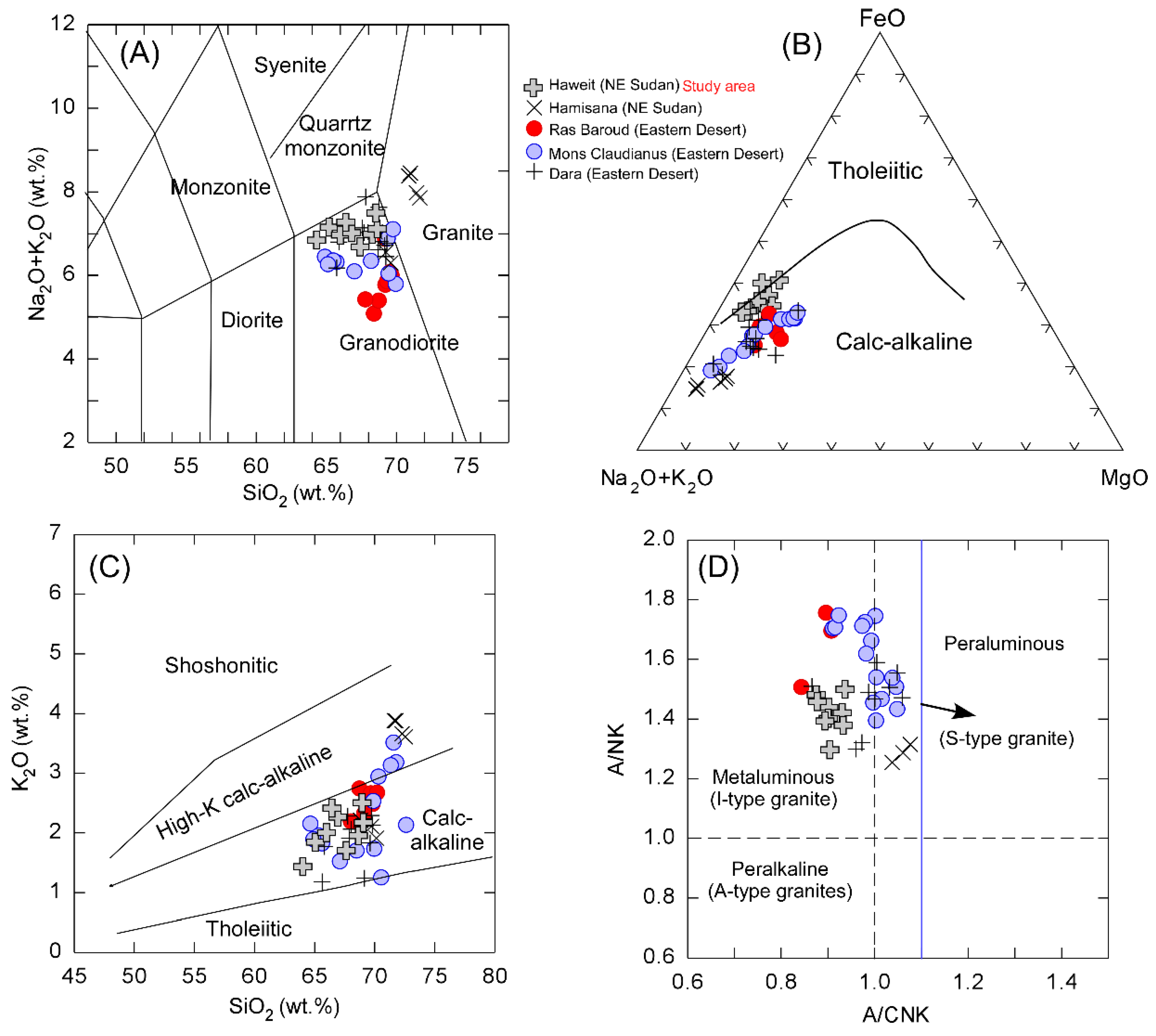
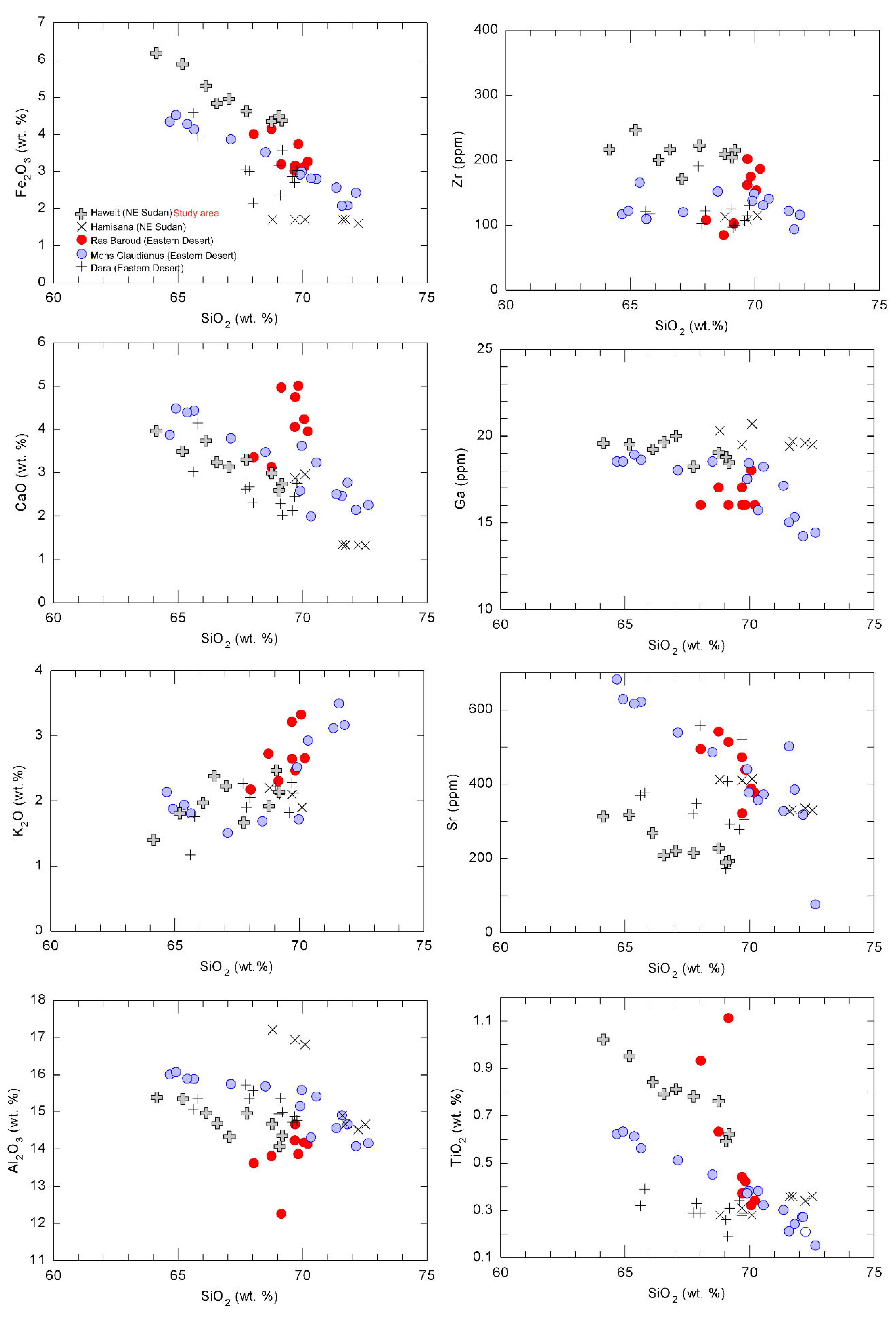

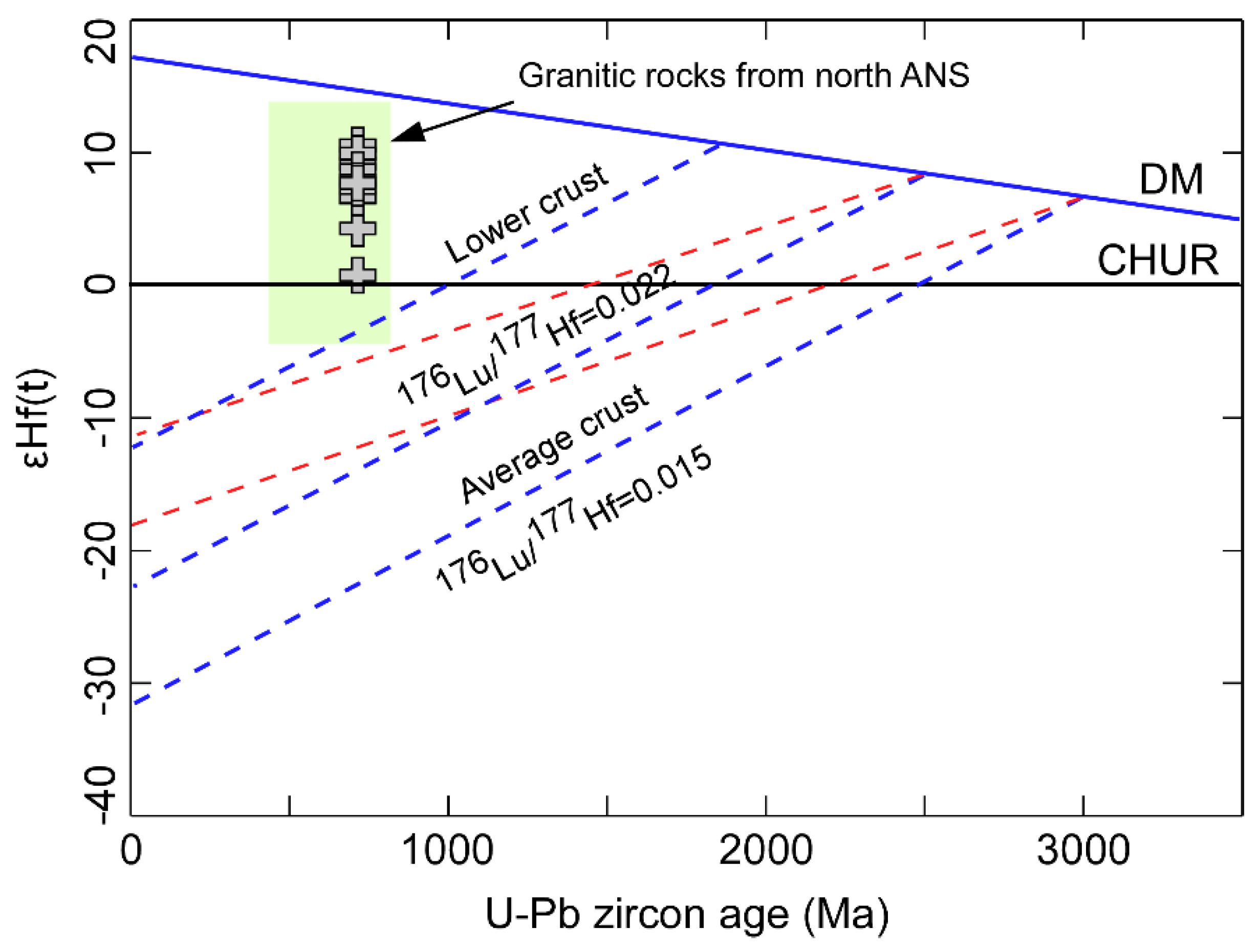

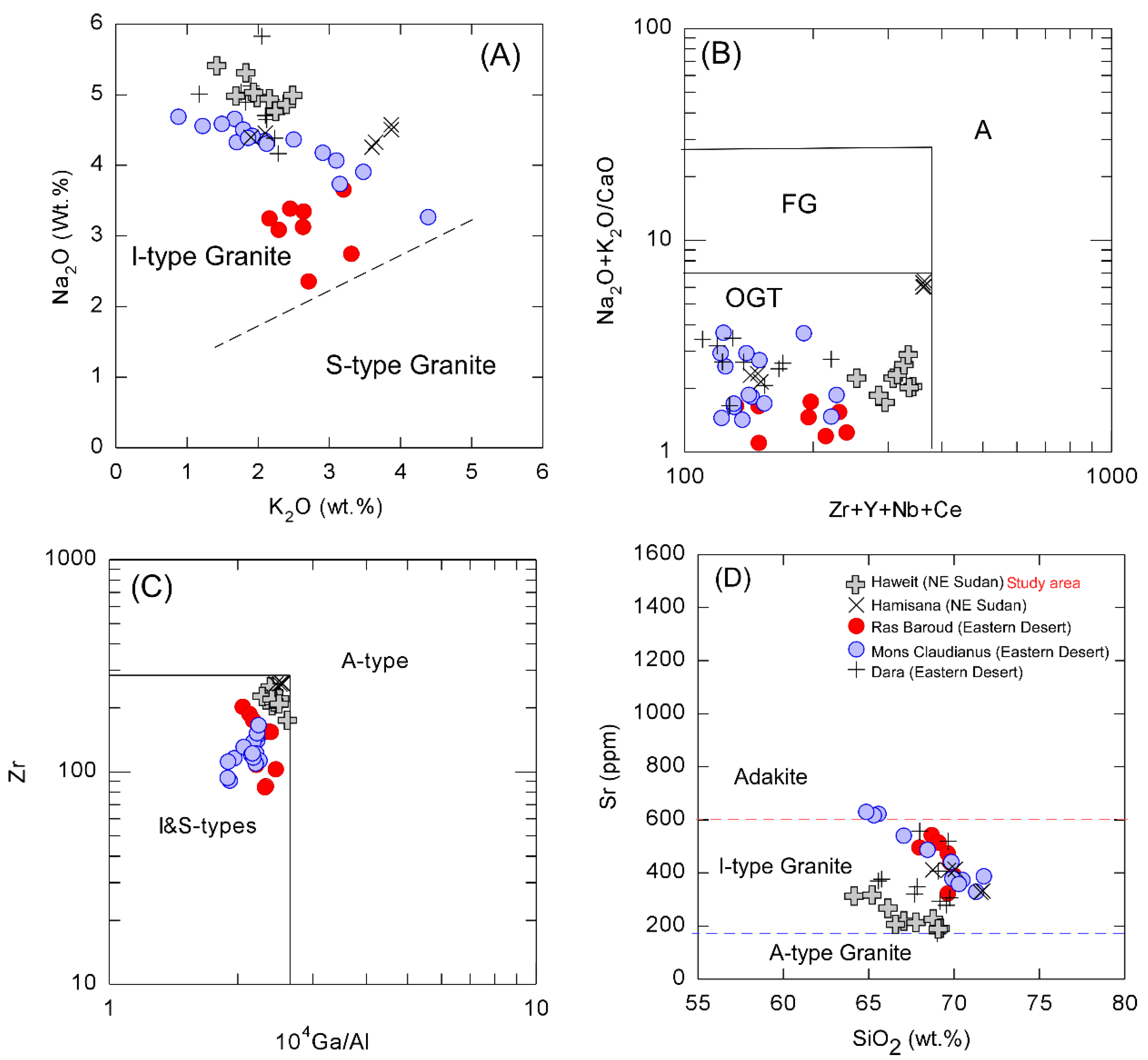
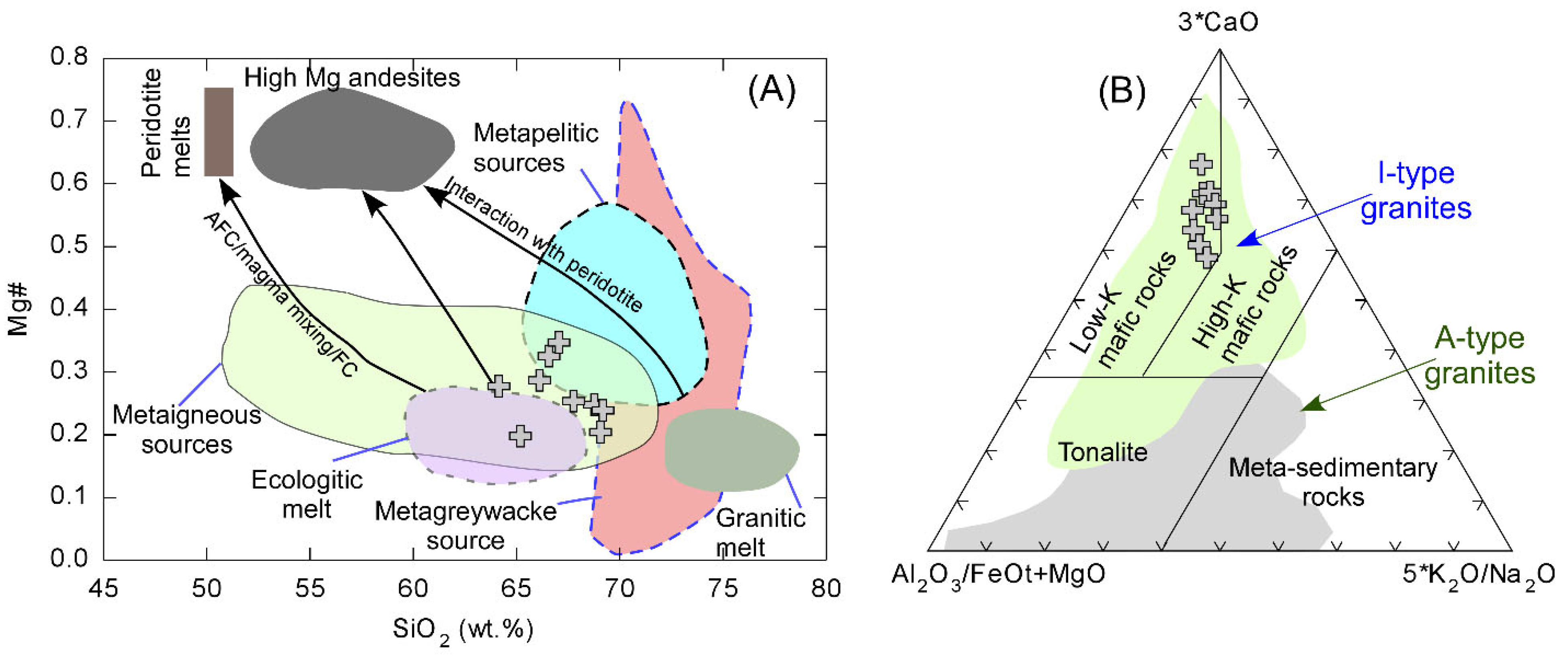



| Grain | Th (ppm) | U (ppm) | Th/U | Isotopic Ratios | Apparent Ages (Ma) | |||||||||
|---|---|---|---|---|---|---|---|---|---|---|---|---|---|---|
| 207Pb/206Pb | 1σ | 207Pb/235U | 1σ | 206Pb/238U | 1σ | 207Pb/235U | 1σ | 206Pb/238U | 1σ | Conc% | ||||
| HG-01 | 684 | 1681 | 0.41 | 0.071951 | 0.002303 | 1.122183 | 0.048025 | 0.110981 | 0.001669 | 764 | 23 | 678 | 10 | 88% |
| HG-02 * | 327 | 1043 | 0.31 | 0.062032 | 0.001613 | 0.992674 | 0.026553 | 0.115796 | 0.001730 | 700 | 14 | 706 | 10 | 99% |
| HG-03 | 778 | 1239 | 0.63 | 0.069836 | 0.001975 | 0.998715 | 0.032159 | 0.102915 | 0.001466 | 703 | 16 | 631 | 9 | 89% |
| HG-04 * | 567 | 871 | 0.65 | 0.063751 | 0.002428 | 1.087243 | 0.051132 | 0.118599 | 0.001258 | 747 | 74 | 722 | 14 | 96% |
| HG-05 | 603 | 896 | 0.67 | 0.067973 | 0.002475 | 1.090820 | 0.048106 | 0.114938 | 0.001920 | 749 | 23 | 701 | 11 | 93% |
| HG-06 * | 1699 | 5268 | 0.32 | 0.064359 | 0.001544 | 1.060474 | 0.029404 | 0.118855 | 0.001408 | 734 | 14 | 724 | 8 | 98% |
| HG-07 * | 2125 | 5521 | 0.38 | 0.063863 | 0.001958 | 1.068074 | 0.038638 | 0.120883 | 0.001942 | 738 | 19 | 736 | 11 | 99% |
| HG-08 | 2997 | 2418 | 1.24 | 0.066856 | 0.001881 | 0.953077 | 0.027434 | 0.102372 | 0.001306 | 680 | 14 | 628 | 8 | 92% |
| HG-09 | 3002 | 8382 | 0.36 | 0.077196 | 0.002000 | 1.160365 | 0.033885 | 0.107787 | 0.002290 | 782 | 16 | 660 | 13 | 83% |
| HG-10 * | 472 | 1660 | 0.28 | 0.061970 | 0.001882 | 0.997502 | 0.032758 | 0.116906 | 0.001849 | 703 | 17 | 713 | 11 | 98% |
| HG-11 * | 799 | 2853 | 0.28 | 0.063721 | 0.001204 | 1.024503 | 0.020251 | 0.116564 | 0.001916 | 716 | 10 | 709 | 11 | 99% |
| HG-12 * | 1883 | 4829 | 0.39 | 0.065509 | 0.001628 | 1.045052 | 0.031053 | 0.116627 | 0.001629 | 728 | 16 | 712 | 10 | 98% |
| HG-13 | 1435 | 2889 | 0.50 | 0.089446 | 0.002187 | 1.509540 | 0.043476 | 0.120787 | 0.001608 | 934 | 18 | 735 | 9 | 76% |
| HG-14 | 859 | 1562 | 0.55 | 0.063245 | 0.005642 | 0.871739 | 0.074914 | 0.099064 | 0.003667 | 637 | 41 | 609 | 22 | 95% |
| HG-15 * | 1754 | 3189 | 0.55 | 0.065369 | 0.002518 | 1.045109 | 0.040574 | 0.116904 | 0.002606 | 726 | 20 | 711 | 14 | 98% |
| HG-16 * | 716 | 981 | 0.73 | 0.063628 | 0.001751 | 1.032021 | 0.023615 | 0.116202 | 0.001469 | 719 | 13 | 709 | 9 | 99% |
| HG-17 * | 446 | 554 | 0.81 | 0.065461 | 0.014180 | 1.052993 | 0.023474 | 0.116476 | 0.002704 | 731 | 12 | 708 | 13 | 98% |
| HG-18 | 620 | 2443 | 0.25 | 0.067220 | 0.001836 | 1.073239 | 0.032842 | 0.114563 | 0.001356 | 740 | 16 | 699 | 8 | 94% |
| HG-19 * | 270 | 1009 | 0.27 | 0.065454 | 0.001434 | 1.052563 | 0.022822 | 0.115383 | 0.002503 | 732 | 13 | 706 | 14 | 99% |
| HG-20 | 1100 | 2086 | 0.53 | 0.072646 | 0.010497 | 0.880401 | 0.056281 | 0.101147 | 0.007999 | 641 | 30 | 621 | 47 | 96% |
| HG-21 * | 592 | 1057 | 0.56 | 0.065925 | 0.000906 | 1.046208 | 0.015941 | 0.115628 | 0.001615 | 727 | 8 | 706 | 10 | 97% |
| HG-22 * | 391 | 954 | 0.41 | 0.066691 | 0.000891 | 1.067519 | 0.021624 | 0.116517 | 0.001835 | 735 | 12 | 711 | 12 | 98% |
| Sample | HG1 | HG2 | HG3 | HG4 | HG5 | HG6 | HG7 | HG8 | HG9 |
|---|---|---|---|---|---|---|---|---|---|
| SiO2 | 64.14 | 65.19 | 66.12 | 67.05 | 66.57 | 67.76 | 68.77 | 69.18 | 69.07 |
| TiO2 | 1.02 | 0.95 | 0.84 | 0.81 | 0.79 | 0.78 | 0.76 | 0.62 | 0.59 |
| Al2O3 | 15.41 | 15.37 | 14.99 | 14.35 | 14.71 | 14.98 | 14.69 | 14.38 | 14.09 |
| MgO | 1.18 | 0.72 | 1.06 | 1.31 | 1.16 | 0.78 | 0.71 | 0.68 | 0.57 |
| Fe2O3 | 6.17 | 5.88 | 5.29 | 4.94 | 4.82 | 4.61 | 4.33 | 4.36 | 4.47 |
| CaO | 3.94 | 3.47 | 3.72 | 3.11 | 3.22 | 3.28 | 2.97 | 2.72 | 2.57 |
| Na2O | 5.41 | 5.31 | 4.96 | 4.76 | 4.86 | 4.98 | 5.03 | 4.94 | 4.99 |
| K2O | 1.41 | 1.82 | 1.98 | 2.24 | 2.39 | 1.68 | 1.93 | 2.15 | 2.48 |
| MnO | 0.11 | 0.08 | 0.08 | 0.09 | 0.08 | 0.07 | 0.07 | 0.08 | 0.07 |
| P2O5 | 0.33 | 0.28 | 0.23 | 0.17 | 0.21 | 0.18 | 0.17 | 0.19 | 0.18 |
| LOI | 0.76 | 0.94 | 0.84 | 0.89 | 0.83 | 0.81 | 0.89 | 0.88 | 0.97 |
| Sum | 99.88 | 100.01 | 100.1 | 99.72 | 99.64 | 99.91 | 100.3 | 100.2 | 100.1 |
| V | 29.3 | 28.4 | 21.6 | 20 | 21.3 | 25.6 | 23.0 | 24.9 | 20.2 |
| Cr | 6.7 | 5.6 | 4.5 | 4.9 | 4.6 | 4.4 | 4.8 | 4.3 | 4.1 |
| Ga | 19.5 | 19.5 | 19.2 | 2.0 | 19.6 | 18.2 | 19.0 | 18.4 | 18.7 |
| Rb | 48 | 63 | 65 | 68 | 69 | 75 | 71 | 73 | 93 |
| Sr | 314 | 318 | 269 | 221 | 209 | 216 | 228 | 194 | 191 |
| Y | 14 | 17 | 22 | 25 | 29 | 35 | 32 | 41 | 46 |
| Zr | 217 | 247 | 201 | 172 | 217 | 223 | 210 | 216 | 205 |
| Nb | 7.78 | 8.35 | 6.72 | 6.04 | 6.77 | 8.69 | 8.13 | 8.53 | 7.9 |
| Cs | 0.15 | 0.22 | 0.31 | 0.37 | 0.34 | 0.42 | 0.52 | 0.94 | 0.81 |
| Ba | 457 | 528 | 481 | 437 | 473 | 602 | 599 | 418 | 455 |
| La | 21 | 30 | 24 | 22 | 26 | 28 | 28 | 27 | 34 |
| Ce | 56 | 70 | 55 | 50 | 55 | 69 | 65 | 61 | 75 |
| Pr | 8.37 | 9.32 | 7.75 | 6.64 | 7.11 | 9.78 | 8.78 | 7.37 | 8.81 |
| Nd | 37 | 38 | 31 | 27 | 28 | 40 | 36 | 30 | 33 |
| Sm | 9.35 | 8.39 | 7.27 | 6.23 | 6.77 | 8.83 | 7.94 | 6.95 | 7.19 |
| Eu | 2.02 | 2.08 | 1.58 | 1.34 | 1.44 | 1.91 | 1.82 | 0.93 | 0.98 |
| Gd | 8.73 | 7.52 | 6.57 | 5.74 | 6.01 | 7.45 | 7.03 | 6.53 | 5.86 |
| Tb | 1.42 | 1.09 | 1.06 | 0.91 | 0.98 | 1.12 | 1.04 | 1.18 | 1.31 |
| Dy | 8.03 | 6.21 | 6.11 | 5.22 | 5.81 | 6.55 | 5.97 | 7.33 | 6.16 |
| Ho | 1.71 | 1.27 | 1.26 | 1.08 | 1.19 | 1.28 | 1.22 | 1.62 | 1.39 |
| Er | 4.61 | 3.56 | 3.49 | 3.04 | 3.46 | 3.69 | 3.36 | 5.06 | 4.12 |
| Tm | 0.71 | 0.52 | 0.57 | 0.47 | 0.53 | 0.55 | 0.49 | 0.84 | 0.74 |
| Yb | 4.81 | 3.47 | 3.56 | 3.32 | 3.53 | 3.66 | 3.29 | 6.11 | 5.01 |
| Lu | 0.72 | 0.52 | 0.57 | 0.51 | 0.59 | 0.54 | 0.55 | 1.01 | 0.84 |
| Hf | 11.3 | 8.6 | 9.2 | 9.8 | 10.4 | 9.5 | 9.6 | 9.2 | 8.3 |
| Ta | 0.5 | 0.5 | 0.6 | 0.5 | 0.6 | 0.6 | 0.5 | 0.8 | 0.7 |
| Th | 4.6 | 6.4 | 4.8 | 4.9 | 5.8 | 6.5 | 5.7 | 7.4 | 6.9 |
| U | 2.1 | 3.2 | 2.5 | 2.4 | 2.8 | 3.2 | 3 | 5.8 | 5.2 |
| A/CNK | 0.88 | 0.90 | 0.86 | 0.90 | 0.84 | 0.94 | 0.93 | 0.93 | 0.91 |
| K2O/Na2O | 0.26 | 0.34 | 0.40 | 0.47 | 0.49 | 0.34 | 0.38 | 0.44 | 0.50 |
| Eu/Eu* | 0.67 | 0.8 | 0.7 | 0.68 | 0.67 | 0.72 | 0.74 | 0.42 | 0.44 |
| ∑REE | 165 | 182 | 149 | 134 | 144 | 182 | 170 | 161 | 183 |
| (La/Yb)N | 3 | 5.91 | 4.48 | 4.44 | 4.54 | 5.25 | 5.7 | 3.02 | 4.66 |
| (Gd/Yb)N | 1.46 | 1.75 | 1.49 | 1.4 | 1.38 | 1.65 | 1.73 | 0.86 | 0.95 |
| (Y/Nb)N | 0.88 | 0.63 | 0.73 | 0.76 | 0.76 | 0.62 | 0.61 | 0.87 | 0.75 |
| Grain No# | t (Ma) | 176Yb/177Hf | 1σ | 176Lu/177Hf | 1σ | 176Hf/177Hf | 1σ | εHf(0) | εHf(t) | tDM1 | tcDM | fLu/Hf |
|---|---|---|---|---|---|---|---|---|---|---|---|---|
| HG-02 | 719 | 0.055252 | 0.001842 | 0.001640 | 0.000046 | 0.282553 | 0.000034 | −7.75 | 7.34 | 885 | 985 | −0.95 |
| HG-04 | 719 | 0.078755 | 0.001712 | 0.002171 | 0.000034 | 0.282561 | 0.000046 | −7.45 | 7.39 | 885 | 981 | −0.93 |
| HG-06 | 719 | 0.044282 | 0.001068 | 0.001303 | 0.000025 | 0.282568 | 0.000024 | −7.20 | 8.06 | 855 | 939 | −0.96 |
| HG-07 | 719 | 0.011551 | 0.000050 | 0.000308 | 0.000000 | 0.282606 | 0.000034 | −5.88 | 9.85 | 781 | 822 | −0.99 |
| HG-10 | 719 | 0.086647 | 0.002029 | 0.002568 | 0.000055 | 0.282655 | 0.000032 | −4.15 | 10.51 | 757 | 779 | −0.92 |
| HG-11 | 719 | 0.058733 | 0.001180 | 0.002066 | 0.000045 | 0.282617 | 0.000041 | −5.50 | 9.40 | 802 | 851 | −0.94 |
| HG-12 | 719 | 0.032830 | 0.000163 | 0.000989 | 0.000002 | 0.282653 | 0.000027 | −4.21 | 11.21 | 728 | 734 | −0.97 |
| HG-15 | 719 | 0.121202 | 0.001186 | 0.003960 | 0.000027 | 0.282682 | 0.000052 | −3.17 | 10.82 | 746 | 759 | −0.88 |
| HG-16 | 719 | 0.053642 | 0.000269 | 0.001343 | 0.000001 | 0.282641 | 0.000055 | −4.63 | 10.61 | 752 | 772 | −0.96 |
| HG-17 | 719 | 0.011109 | 0.000046 | 0.000296 | 0.000001 | 0.282565 | 0.000029 | −7.31 | 8.43 | 836 | 915 | −0.99 |
| HG-19 | 719 | 0.066214 | 0.003906 | 0.002018 | 0.000102 | 0.282594 | 0.000026 | −6.30 | 8.62 | 834 | 902 | −0.94 |
| HG-21 | 719 | 0.013041 | 0.000032 | 0.000348 | 0.000001 | 0.282566 | 0.000027 | −7.29 | 8.43 | 837 | 915 | −0.99 |
Disclaimer/Publisher’s Note: The statements, opinions and data contained in all publications are solely those of the individual author(s) and contributor(s) and not of MDPI and/or the editor(s). MDPI and/or the editor(s) disclaim responsibility for any injury to people or property resulting from any ideas, methods, instructions or products referred to in the content. |
© 2023 by the authors. Licensee MDPI, Basel, Switzerland. This article is an open access article distributed under the terms and conditions of the Creative Commons Attribution (CC BY) license (https://creativecommons.org/licenses/by/4.0/).
Share and Cite
Sami, M.; Adam, M.M.A.; Lv, X.; Lasheen, E.S.R.; Ene, A.; Zakaly, H.M.H.; Alarifi, S.S.; Mahdy, N.M.; Abdel Rahman, A.R.A.; Saeed, A.; et al. Petrogenesis and Tectonic Implications of the Cryogenian I-Type Granodiorites from Gabgaba Terrane (NE Sudan). Minerals 2023, 13, 331. https://doi.org/10.3390/min13030331
Sami M, Adam MMA, Lv X, Lasheen ESR, Ene A, Zakaly HMH, Alarifi SS, Mahdy NM, Abdel Rahman ARA, Saeed A, et al. Petrogenesis and Tectonic Implications of the Cryogenian I-Type Granodiorites from Gabgaba Terrane (NE Sudan). Minerals. 2023; 13(3):331. https://doi.org/10.3390/min13030331
Chicago/Turabian StyleSami, Mabrouk, Munir M. A. Adam, Xinbiao Lv, El Saeed R. Lasheen, Antoaneta Ene, Hesham M. H. Zakaly, Saad S. Alarifi, Nasser M. Mahdy, Abdel Rahman A. Abdel Rahman, Adil Saeed, and et al. 2023. "Petrogenesis and Tectonic Implications of the Cryogenian I-Type Granodiorites from Gabgaba Terrane (NE Sudan)" Minerals 13, no. 3: 331. https://doi.org/10.3390/min13030331
APA StyleSami, M., Adam, M. M. A., Lv, X., Lasheen, E. S. R., Ene, A., Zakaly, H. M. H., Alarifi, S. S., Mahdy, N. M., Abdel Rahman, A. R. A., Saeed, A., Farahat, E. S., Fathy, D., & Ali, S. (2023). Petrogenesis and Tectonic Implications of the Cryogenian I-Type Granodiorites from Gabgaba Terrane (NE Sudan). Minerals, 13(3), 331. https://doi.org/10.3390/min13030331











